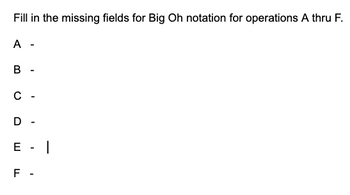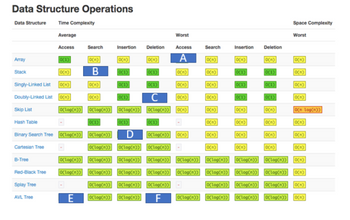
Database System Concepts
7th Edition
ISBN: 9780078022159
Author: Abraham Silberschatz Professor, Henry F. Korth, S. Sudarshan
Publisher: McGraw-Hill Education
expand_more
expand_more
format_list_bulleted
Concept explainers
Question

Transcribed Image Text:### Activity: Understanding Big O Notation
**Instruction**: Fill in the missing fields for Big O notation for operations A through F.
- **A -**
- **B -**
- **C -**
- **D -**
- **E -**
- **F -**
This activity is designed to help students practice and understand Big O notation, which is essential for analyzing the time complexity of algorithms. Consider typical algorithm complexities such as O(1), O(n), O(log n), O(n^2), etc., to complete the exercise.

Transcribed Image Text:# Data Structure Operations
This table outlines the time and space complexities for various operations in different data structures. It is divided into categories such as average and worst time complexity for operations like access, search, insertion, and deletion. Space complexity in the worst-case scenario is also included.
### Table Structure:
- First column lists various data structures.
- Subsequent columns provide time complexity for each operation under average and worst conditions.
- The last column shows the worst-case space complexity.
### Data Structure and Complexity:
1. **Array**
- Average: Access: O(1), Search: O(n), Insertion: O(n), Deletion: O(n)
- Worst: Access: O(1), Search: O(n), Insertion: O(n), Deletion: O(n), Space: O(n)
2. **Stack**
- Average & Worst: Access: O(n), Search: O(n), Insertion: O(1), Deletion: O(1), Space: O(n)
3. **Singly-Linked List**
- Average & Worst: Access: O(n), Search: O(n), Insertion: O(1), Deletion: O(1), Space: O(n)
4. **Doubly-Linked List**
- Average & Worst: Access: O(n), Search: O(n), Insertion: O(1), Deletion: O(1), Space: O(n)
5. **Skip List**
- Average: Access: O(log(n)), Search: O(log(n)), Insertion: O(log(n)), Deletion: O(log(n))
- Worst: Access: O(n), Search: O(n), Insertion: O(n), Deletion: O(n), Space: O(n log(n))
6. **Hash Table**
- Average: Access: N/A, Search: O(1), Insertion: O(1), Deletion: O(1)
- Worst: Access: N/A, Search: O(n), Insertion: O(n), Deletion: O(n), Space: O(n)
7. **Binary Search Tree**
- Average: Access: O(log(n)), Search: O(log(n)), Insertion: O(log(n)), Deletion: O(log(n))
- Worst: Access: O(n), Search: O(n), Insertion: O(n), Deletion: O(n), Space: O(n)
8.
Expert Solution
This question has been solved!
Explore an expertly crafted, step-by-step solution for a thorough understanding of key concepts.
This is a popular solution
Trending nowThis is a popular solution!
Step by stepSolved in 3 steps

Knowledge Booster
Learn more about
Need a deep-dive on the concept behind this application? Look no further. Learn more about this topic, computer-science and related others by exploring similar questions and additional content below.Similar questions
- Solve T(n) 4T(n/2) + O(n³) using the recursion tree method. • Tree depth: • each subproblem size at depth d:arrow_forwarddescribe a major favor that would influence the decision to use a binary search tree structure instead of an ordered linked list or a sorted arrayarrow_forwardWhen compared to alternative data structures, such as a linked list or an array, the advantages of a binary search tree are clear.arrow_forward
arrow_back_ios
arrow_forward_ios
Recommended textbooks for you
 Database System ConceptsComputer ScienceISBN:9780078022159Author:Abraham Silberschatz Professor, Henry F. Korth, S. SudarshanPublisher:McGraw-Hill Education
Database System ConceptsComputer ScienceISBN:9780078022159Author:Abraham Silberschatz Professor, Henry F. Korth, S. SudarshanPublisher:McGraw-Hill Education Starting Out with Python (4th Edition)Computer ScienceISBN:9780134444321Author:Tony GaddisPublisher:PEARSON
Starting Out with Python (4th Edition)Computer ScienceISBN:9780134444321Author:Tony GaddisPublisher:PEARSON Digital Fundamentals (11th Edition)Computer ScienceISBN:9780132737968Author:Thomas L. FloydPublisher:PEARSON
Digital Fundamentals (11th Edition)Computer ScienceISBN:9780132737968Author:Thomas L. FloydPublisher:PEARSON C How to Program (8th Edition)Computer ScienceISBN:9780133976892Author:Paul J. Deitel, Harvey DeitelPublisher:PEARSON
C How to Program (8th Edition)Computer ScienceISBN:9780133976892Author:Paul J. Deitel, Harvey DeitelPublisher:PEARSON Database Systems: Design, Implementation, & Manag...Computer ScienceISBN:9781337627900Author:Carlos Coronel, Steven MorrisPublisher:Cengage Learning
Database Systems: Design, Implementation, & Manag...Computer ScienceISBN:9781337627900Author:Carlos Coronel, Steven MorrisPublisher:Cengage Learning Programmable Logic ControllersComputer ScienceISBN:9780073373843Author:Frank D. PetruzellaPublisher:McGraw-Hill Education
Programmable Logic ControllersComputer ScienceISBN:9780073373843Author:Frank D. PetruzellaPublisher:McGraw-Hill Education

Database System Concepts
Computer Science
ISBN:9780078022159
Author:Abraham Silberschatz Professor, Henry F. Korth, S. Sudarshan
Publisher:McGraw-Hill Education

Starting Out with Python (4th Edition)
Computer Science
ISBN:9780134444321
Author:Tony Gaddis
Publisher:PEARSON

Digital Fundamentals (11th Edition)
Computer Science
ISBN:9780132737968
Author:Thomas L. Floyd
Publisher:PEARSON

C How to Program (8th Edition)
Computer Science
ISBN:9780133976892
Author:Paul J. Deitel, Harvey Deitel
Publisher:PEARSON

Database Systems: Design, Implementation, & Manag...
Computer Science
ISBN:9781337627900
Author:Carlos Coronel, Steven Morris
Publisher:Cengage Learning

Programmable Logic Controllers
Computer Science
ISBN:9780073373843
Author:Frank D. Petruzella
Publisher:McGraw-Hill Education